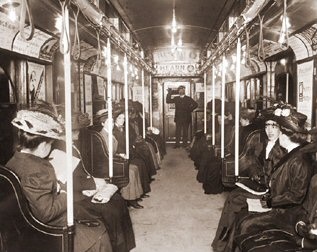Any woman who has taken mass transit for any amount of time (or, in some cases, at all), has, no doubt, experienced or witnessed sexual harassment.
Harassment on public transportation is a common topic on my blog, from posts highlighting studies about harassment on public transportation, to posts about women who won’t stand for harassment, to posts about the latest country to start women-only buses or subway cars as a “quick fix.” It was also the topic of my presentation last month at Third International Conference on Women’s Safety: Building Inclusive Cities (where I argued that women-only cars are not long-term solutions and do not challenge or end harassment).
I think sometimes we may think that “back in the day” people were civilized, there was no street harassment, no harassment on public transportation. Sadly, this is simply not true. As long as there has been gender inequality and a societal disrespect for women there has been street harassment and as long as there has been public transportation, the harassment has occurred there.

The latest evidence of this tradition of harassment came to my attention via a post on the blog Ephemeral New York (thanks to my colleague ChristyTJ for the link).
In the post the author writes how in 1909 there was a test run of women-only subway cars (“suffragette cars”) during rush hour on the trains of the Hudson Tubes (today’s PATH). They were suggested because of inappropriate behavior by some men toward women riders. In the end, there was enough opposition to the idea, including from women, that women-only subway cars were never implemented.
“Within eight years of its opening, the transit system was being criticized for the sexual harassment of women and girls, who, although they accounted for only about a quarter of all peak hour passengers, were forced to endure jostling and unwelcome sexual contact….
One solution the transit system rejected was cars solely for women, although years later the system would embrace the idea of cars for students travelling between school and home in the afternoon hours. The transit system, though, continued to receive criticism about the safety of women riders. A few years later, women police officers worked as decoys to contain the behavior of men who made it ‘their business to insult and annoy women and girls.’…
As early as 1909—only five years after the IRT opened—a prominent leader of the Women’s Municipal League proposed that it reserve the last car of every rush hour train for women. At a time when women’s separate spheres in most aspects of public life were taken for granted by men and women, Julia D. Longfellow advocated this male-free space to assure that women were not forced to cope with “the fearful crushes,” and with sexual insults, and that they would not have to safeguard themselves from men’s sexual aggression. A secondary purpose of her demand for segregated cars was less benevolent. Longfellow, representing the views of many upper-class women of her time, believed that some working-class women were willing participants in this subway rowdiness, and that creation of women’s only cars would lead to more ladylike behavior by those who needed such reforming
The IRT rejected the idea, but women’s safety—or lack of it—whether real or perceived—remained a public concern. In 1918, when the first policewomen entered the New York City Police Department under a new, female fifth deputy commissioner, one of their first assignments was to attack the problems of white slavery and men who annoyed women on the streets, in the subways, and on the elevated trains—problems that were seen, at least in part, as related.
Those familiar with Progressive Era concerns about white slavery know that creation of such groups as the Traveller’s Aid Society were directly related to demands that women be present in train stations to protect young women, often runaways or working-class immigrants, from the clutches of those perceived as ready to lure them into lives of prostitution. Early policewomen, too, spent much of their time patrolling train stations, with the expressed aim of saving women from the perils believed awaiting them there.
Thus concern about women and their safety in and around transit systems has a long history and plays an important role in women’s demands for public positions in both the social service and criminal justice fields.”
Fascinating. How very little has changed in 100 years!!! I think this historical context helps show that even when there are some measures introduced to stop street harassment and harassment on public transportation, until there is a complete societal shift regarding the acceptability of such behavior, it will not end.
We have yet to achieve that societal shift. And we need it.
